Two-Dimensional Metal-Organic Framework Incorporated Highly Polar PVDF for Dielectric Energy Storage and Mechanical Energy Harvesting
Abstract
1. Introduction
2. Materials and Methods
2.1. Synthesis of 2D Ni-MOF
2.2. Fabrication of the Composite Films and Energy Harvesting Devices
2.3. Characterization Techniques
3. Results and Discussion
3.1. Structure and Morphology of the Synthesized Ni-MOF
3.2. Microstructural and Elemental Characterizations of the Composite Films
3.3. Analysis of Polarity
3.4. Mechanical and Electrical Strengths
3.5. Dielectric, Ferroelectric, and Energy Storage Properties
3.6. Mechanical Energy Harvesting Performances
4. Conclusions
Author Contributions
Funding
Data Availability Statement
Acknowledgments
Conflicts of Interest
References
- Maiti, T.K.; Singh, J.; Majhi, J.; Ahuja, A.; Maiti, S.; Dixit, P.; Bhushan, S.; Bandyopadhyay, A.; Chattopadhyay, S. Advances in Polybenzimidazole Based Membranes for Fuel Cell Applications That Overcome Nafion Membranes Constraints. Polymer 2022, 255, 125151. [Google Scholar] [CrossRef]
- Sardana, S.; Gupta, A.; Singh, K.; Maan, A.S.; Ohlan, A. Conducting Polymer Hydrogel Based Electrode Materials for Supercapacitor Applications. J. Energy Storage 2022, 45, 103510. [Google Scholar] [CrossRef]
- Darwish, M.A.; Zubar, T.I.; Kanafyev, O.D.; Zhou, D.; Trukhanova, E.L.; Trukhanov, S.V.; Trukhanov, A.V.; Henaish, A.M. Combined Effect of Microstructure, Surface Energy, and Adhesion Force on the Friction of PVA/Ferrite Spinel Nanocomposites. Nanomaterials 2022, 12, 1998. [Google Scholar] [CrossRef]
- Korolkov, I.V.; Zhumanazar, N.; Gorin, Y.G.; Yeszhanov, A.B.; Zdorovets, M.V. Enhancement of Electrochemical Detection of Pb2+ by Sensor Based on Track-Etched Membranes Modified with Interpolyelectrolyte Complexes. J. Mater. Sci. Mater. Electron. 2020, 31, 20368–20377. [Google Scholar] [CrossRef]
- Chen, Y.; Yang, Y.; Orr, A.A.; Makam, P.; Redko, B.; Haimov, E.; Wang, Y.; Shimon, L.J.W.; Rencus-Lazar, S.; Ju, M.; et al. Self-Assembled Peptide Nano-Superstructure towards Enzyme Mimicking Hydrolysis. Angew. Chemie 2021, 133, 17301–17307. [Google Scholar] [CrossRef]
- Pei, J.Y.; Yin, L.J.; Zhong, S.L.; Dang, Z.M. Suppressing the Loss of Polymer-Based Dielectrics for High Power Energy Storage. Adv. Mater. 2023, 35, 2203623. [Google Scholar] [CrossRef] [PubMed]
- Yuan, H.; Chen, Y.; Lin, R.; Tan, D.; Zhang, J.; Wang, Y.; Gazit, E.; Ji, W.; Yang, R. Modified Stranski-Krastanov Growth of Amino Acid Arrays toward Piezoelectric Energy Harvesting. ACS Appl. Mater. Interfaces 2022, 14, 46304–46312. [Google Scholar] [CrossRef]
- Jaffar, S.S.; Saallah, S.; Misson, M.; Siddiquee, S.; Roslan, J.; Saalah, S.; Lenggoro, W. Recent Development and Environmental Applications of Nanocellulose-Based Membranes. Membranes 2022, 12, 287. [Google Scholar] [CrossRef] [PubMed]
- Mohammadpourfazeli, S.; Arash, S.; Ansari, A.; Yang, S.; Mallick, K.; Bagherzadeh, R. Future Prospects and Recent Developments of Polyvinylidene Fluoride (PVDF) Piezoelectric Polymer; Fabrication Methods, Structure, and Electro-Mechanical Properties. RSC Adv. 2023, 13, 370–387. [Google Scholar] [CrossRef]
- Panicker, S.S.; Rajeev, S.P.; Thomas, V. Impact of PVDF and Its Copolymer-Based Nanocomposites for Flexible and Wearable Energy Harvesters. Nano-Struct. Nano-Objects 2023, 34, 100949. [Google Scholar] [CrossRef]
- Sasmal, A.; Sen, S.; Devi, P.S. Role of Suppressed Oxygen Vacancies in the BiFeO3 Nanofiller to Improve the Polar Phase and Multifunctional Performance of Poly(Vinylidene Fluoride). Phys. Chem. Chem. Phys. 2019, 21, 5974–5988. [Google Scholar] [CrossRef]
- Chinya, I.; Sen, S. Improved Dielectric and Touch Sensing Performance of Surface Modified Zinc Ferrite (ZF)/Polyvinylidene Fluoride (PVDF) Composite. Sens. Actuators A Phys. 2017, 267, 301–309. [Google Scholar] [CrossRef]
- Sasmal, A.; Patra, A.; Devi, P.S.; Sen, S. Hydroxylated BiFeO3 as Efficient Fillers in Poly(Vinylidene Fluoride) for Flexible Dielectric, Ferroelectric, Energy Storage and Mechanical Energy Harvesting Application. Dalt. Trans. 2021, 50, 1824–1837. [Google Scholar] [CrossRef] [PubMed]
- Padurariu, L.; Horchidan, N.; Ciomaga, C.E.; Curecheriu, L.P.; Lukacs, V.A.; Stirbu, R.S.; Stoian, G.; Botea, M.; Florea, M.; Maraloiu, V.A.; et al. Influence of Ferroelectric Filler Size and Clustering on the Electrical Properties of (Ag-BaTiO3)-PVDF Sub-Percolative Hybrid Composites. ACS Appl. Mater. Interfaces 2022, 15, 5744–5759. [Google Scholar] [CrossRef] [PubMed]
- Agayev, F.G.; Trukhanov, S.V.; Trukhanov, A.V.; Jabarov, S.H.; Ayyubova, G.S.; Mirzayev, M.N.; Trukhanova, E.L.; Vinnik, D.A.; Kozlovskiy, A.L.; Zdorovets, M.V.; et al. Study of Structural Features and Thermal Properties of Barium Hexaferrite upon Indium Doping. J. Therm. Anal. Calorim. 2022, 147, 14107–14114. [Google Scholar] [CrossRef]
- Jiang, J.; Li, J.; Zhang, Y.; Yuan, Y.; Liu, X.; Zuo, P.; Qian, J.; Zhuang, Q. Tuning the Interfacial Insulating Shell Characteristics in CaCu3Ti4O12 Nanowires/Polyetherimide Nanocomposites for High-Temperature Capacitive Energy Storage. J. Mater. Chem. C 2022, 10, 7962–7969. [Google Scholar] [CrossRef]
- Trukhanov, A.V.; Almessiere, M.A.; Baykal, A.; Slimani, Y.; Trukhanova, E.L.; Timofeev, A.V.; Kostishin, V.G.; Trukhanov, S.V.; Sertkol, M.; Ul-Hamid, A. Correlation between the Composition, Structural Parameters and Magnetic Properties of Spinel-Based Functional Nanocomposites. Nano-Struct. Nano-Objects 2023, 33, 100941. [Google Scholar] [CrossRef]
- Kozlovskiy, A.L.; Shlimas, D.I.; Zdorovets, M.V. Synthesis, Structural Properties and Shielding Efficiency of Glasses Based on TeO2-(1-x)ZnO-XSm2O3. J. Mater. Sci. Mater. Electron. 2021, 32, 12111–12120. [Google Scholar] [CrossRef]
- Bhattacharya, G.; Das, S.; Venimadhav, A. Study on the Synergistic Effects of Aqueous Rare Earth Salt and ZnO Nanoparticles on Poly (Vinylidene Fluoride) PVDF Based Self-Polarized, Electroactive Films. Curr. Appl. Phys. 2023, 49, 91–99. [Google Scholar] [CrossRef]
- Zdorovets, M.V.; Kozlovskiy, A.L.; Shlimas, D.I.; Borgekov, D.B. Phase Transformations in FeCo—Fe2CoO4/Co3O4-Spinel Nanostructures as a Result of Thermal Annealing and Their Practical Application. J. Mater. Sci. Mater. Electron. 2021, 32, 16694–16705. [Google Scholar] [CrossRef]
- Mandal, S.; Hou, Y.; Wang, M.; Anthopoulos, T.D.; Choy, K.L. Surface Modification of Hetero-Phase Nanoparticles for Low-Cost Solution-Processable High-k Dielectric Polymer Nanocomposites. ACS Appl. Mater. Interfaces 2023, 15, 7371–7379. [Google Scholar] [CrossRef]
- Zhou, J.; Zhou, W.; Yuan, M.; Dong, X.; Zhang, J.; Zhang, X.; Zhang, Y.; Chen, X.; Chen, Y.; Liu, X. Significantly Suppressed Dielectric Loss and Enhanced Breakdown Strength in Core@Shell Structured Ni@TiO2/PVDF Composites. Nanomaterials 2023, 13, 211. [Google Scholar] [CrossRef]
- Mukherjee, A.; Dasgupta Ghosh, B. Synthesis of Functionalized ZnO Nanoflake Loaded Polyvinylidene Fluoride Composites with Enhanced Energy Storage Properties. Polym. Compos. 2023, 2, 1–12. [Google Scholar] [CrossRef]
- Pratihar, S.; Medda, S.K.; Sen, S.; Devi, P.S. Tailored Piezoelectric Performance of Self-Polarized PVDF-ZnO Composites by Optimization of Aspect Ratio of ZnO Nanorods. Polym. Compos. 2020, 41, 3351–3363. [Google Scholar] [CrossRef]
- Zhu, M.; Li, G.; Xu, H.; Xie, H.; Liao, Y. Controllable Preparation of CaCu3Ti4O12 Nanowires and Its Strengthening Effect on High Dielectric Polymer Composites. J. Mater. Sci. Mater. Electron. 2023, 34, 226. [Google Scholar] [CrossRef]
- Li, G.; Deng, W.; Li, W.; Yang, M.; Cui, W. Synergistic Enhancement in Mechanical, Thermal, and Dielectric Properties of PANI@BT/PVDF Composites by Adding 2D Nanoplatelets. J. Appl. Polym. Sci. 2023, 140, e53565. [Google Scholar] [CrossRef]
- Jangra, M.; Thakur, A.; Dam, S.; Chatterjee, S.; Hussain, S. Enhanced Dielectric Properties of MoS2/PVDF Free-Standing, Flexible Films for Energy Harvesting Applications. Mater. Today Commun. 2023, 34, 105109. [Google Scholar] [CrossRef]
- Bhattacharya, D.; Mukherjee, S.; Pal, A.N.; Mitra, R.K.; Ray, S.K. Two-Dimensional MoxW1−xS2 Alloys for Nanogenerators Producing Record Piezo-Output and Coupled Photodetectors for Self-Powered UV Sensor. Adv. Opt. Mater. 2022, 10, 2200353. [Google Scholar] [CrossRef]
- Wang, B.; Yin, X.; Peng, D.; Zhang, Y.; Wu, W.; Gu, X.; Na, B.; Lv, R.; Liu, H. Highly Thermally Conductive PVDF-Based Ternary Dielectric Composites via Engineering Hybrid Filler Networks. Compos. Part B Eng. 2020, 191, 107978. [Google Scholar] [CrossRef]
- Bhattacharya, D.; Bayan, S.; Mitra, R.K.; Ray, S.K. 2D WS2embedded PVDF Nanocomposites for Photosensitive Piezoelectric Nanogenerators with a Colossal Energy Conversion Efficiency of ∼25.6%. Nanoscale 2021, 13, 15819–15829. [Google Scholar] [CrossRef] [PubMed]
- Rajavel, K.; Luo, S.; Wan, Y.; Yu, X.; Hu, Y.; Zhu, P.; Sun, R.; Wong, C. 2D Ti3C2Tx MXene/Polyvinylidene Fluoride (PVDF) Nanocomposites for Attenuation of Electromagnetic Radiation with Excellent Heat Dissipation. Compos. Part A Appl. Sci. Manuf. 2020, 129, 105693. [Google Scholar] [CrossRef]
- Bayan, S.; Bhattacharya, D.; Mitra, R.K.; Ray, S.K.; Ray, S.K. Self-Powered Flexible Photodetectors Based on Ag Nanoparticle-Loaded g-C3N4nanosheets and PVDF Hybrids: Role of Plasmonic and Piezoelectric Effects. Nanotechnology 2020, 31, 365401. [Google Scholar] [CrossRef]
- Kar, E.; Bose, N.; Dutta, B.; Mukherjee, N.; Mukherjee, S. Poly(Vinylidene Fluoride)/Submicron Graphite Platelet Composite_ A Smart, Lightweight Flexible Material with Significantly Enhanced β Polymorphism, Dielectric and Microwave Shielding Properties. Eur. Polym. J. 2017, 90, 442–455. [Google Scholar] [CrossRef]
- Agbabiaka, O.G.; Adegun, M.H.; Chan, K.Y.; Zhang, H.; Shen, X.; Kim, J.K. BN-PVDF/RGO-PVDF Laminate Nanocomposites for Energy Storage Applications. Nanomaterials 2022, 12, 4492. [Google Scholar] [CrossRef]
- Chen, Y.; Guerin, S.; Yuan, H.; O’Donnell, J.; Xue, B.; Cazade, P.A.; Haq, E.U.; Shimon, L.J.W.; Rencus-Lazar, S.; Tofail, S.A.M.; et al. Guest Molecule-Mediated Energy Harvesting in a Conformationally Sensitive Peptide-Metal Organic Framework. J. Am. Chem. Soc. 2022, 144, 3468–3476. [Google Scholar] [CrossRef] [PubMed]
- Chu, R.; Weng, L.; Guan, L.; Liu, J.; Zhang, X.; Wu, Z. Preparation and Properties Comparison of ZIF-67/PVDF and SiCNWs/PVDF Composites for Energy Storage. J. Mater. Sci. Mater. Electron. 2023, 34, 347. [Google Scholar] [CrossRef]
- Yan, Z.; Yang, Y.; Cai, X. Preparation of a Ferroelectric Composite Film Metal–Organic Framework/PVDF. J. Polym. Res. 2020, 27, 377. [Google Scholar] [CrossRef]
- Sinha, C.; Mandal, D.; Roy, K.; Jana, S.; Ghosh, S.K.; Mahanty, B.; Mallick, Z.; Sarkar, S. Three-Dimensional MOF-Assisted Self-Polarized Ferroelectret: An Effective Autopowered Remote Healthcare Monitoring Approach. Langmuir 2020, 36, 11477–11489. [Google Scholar] [CrossRef]
- Roy, K.; Jana, S.; Mallick, Z.; Ghosh, S.K.; Dutta, B.; Sarkar, S.; Sinha, C.; Mandal, D. Two-Dimensional MOF Modulated Fiber Nanogenerator for Effective Acoustoelectric Conversion and Human Motion Detection. Langmuir 2021, 37, 7107–7117. [Google Scholar] [CrossRef]
- Guan, L.; Weng, L.; Chen, N.; Kannan, H.; Li, Q.; Zhang, X.; Wu, Z.; Ma, Y.; Sahu, A. Bimetallic Organic Framework NiFeMOF Driven by Tiny Ag Particles for PVDF Dielectric Composites. Compos. Part A Appl. Sci. Manuf. 2021, 147, 106432. [Google Scholar] [CrossRef]
- Asadi, K.; van der Veen, M.A. Ferroelectricity in Metal–Organic Frameworks: Characterization and Mechanisms. Eur. J. Inorg. Chem. 2016, 2016, 4332–4344. [Google Scholar] [CrossRef]
- Sasmal, A.; Sen, S.; Arockiarajan, A. Strategies Involved in Enhancing the Capacitive Energy Storage Characteristics of Poly(Vinylidene Fluoride) Based Flexible Composites. ChemistrySelect 2022, 7, e202202058. [Google Scholar] [CrossRef]
- Bi, M.; Hao, Y.; Zhang, J.; Lei, M.; Bi, K. Particle Size Effect of BaTiO3 Nanofillers on the Energy Storage Performance of Polymer Nanocomposites. Nanoscale 2017, 9, 16386–16395. [Google Scholar] [CrossRef]
- Sahu, M.; Vivekananthan, V.; Hajra, S.; Abisegapriyan, K.S.; Maria Joseph Raj, N.P.; Kim, S.J. Synergetic Enhancement of Energy Harvesting Performance in Triboelectric Nanogenerator Using Ferroelectric Polarization for Self-Powered IR Signaling and Body Activity Monitoring. J. Mater. Chem. A 2020, 8, 22257–22268. [Google Scholar] [CrossRef]
- Sun, F.; Wang, G.; Ding, Y.; Wang, C.; Yuan, B.; Lin, Y. NiFe-Based Metal–Organic Framework Nanosheets Directly Supported on Nickel Foam Acting as Robust Electrodes for Electrochemical Oxygen Evolution Reaction. Adv. Energy Mater. 2018, 8, 1800584. [Google Scholar] [CrossRef]
- Mesbah, A.; Rabu, P.; Sibille, R.; Mazet, T.; Malaman, B.; Franc, M.; Lamour, I.J.; Cnrs, U.M.R.; De Lorraine, U.; Botanique, J. From Hydrated Ni3(OH)2(C8H4O4)2(H2O)4 to Anhydrous Ni2(OH)2(C8H4O4): Impact of Structural Transformations on Magnetic Properties. Inorg. Chem. 2014, 53, 872–881. [Google Scholar] [CrossRef] [PubMed]
- Martins, P.; Lopes, A.C.; Lanceros-Mendez, S. Electroactive Phases of Poly(Vinylidene Fluoride): Determination, Processing and Applications. Prog. Polym. Sci. 2014, 39, 683–706. [Google Scholar] [CrossRef]
- Cai, X.; Lei, T.; Sun, D.; Lin, L. A Critical Analysis of the α, β and γ Phases in Poly(Vinylidene Fluoride) Using FTIR. RSC Adv. 2017, 7, 15382–15389. [Google Scholar] [CrossRef]
- Mondal, S.; Paul, T.; Maiti, S.; Das, B.K.; Chattopadhyay, K.K. Human Motion Interactive Mechanical Energy Harvester Based on All Inorganic Perovskite-PVDF. Nano Energy 2020, 74, 104870. [Google Scholar] [CrossRef]
- Maity, S.; Sasmal, A.; Sen, S. Barium Titanate Based Paraelectric Material Incorporated Poly(Vinylidene Fluoride) for Biomechanical Energy Harvesting and Self-Powered Mechanosensing. Mater. Sci. Semicond. Process. 2023, 153, 107128. [Google Scholar] [CrossRef]
- Chinya, I.; Pal, A.; Sen, S. Polyglycolated Zinc Ferrite Incorporated Poly(Vinylidene Fluoride)(PVDF) Composites with Enhanced Piezoelectric Response. J. Alloys Compd. 2017, 722, 829–838. [Google Scholar] [CrossRef]
- Srivastava, A.; Jana, K.K.; Maiti, P.; Kumar, D.; Parkash, O. Poly(Vinylidene Fluoride)/CaCu3Ti4O12 and La Doped CaCu3Ti4O12 Composites with Improved Dielectric and Mechanical Properties. Mater. Res. Bull. 2015, 70, 735–742. [Google Scholar] [CrossRef]
- Cao, Q.; Zhu, W.; Chen, W.; Chen, X.; Yang, R.; Yang, S.; Zhang, H.; Gui, X.; Chen, J. Nonsolid TiOxNanoparticles/PVDF Nanocomposite for Improved Energy Storage Performance. ACS Appl. Mater. Interfaces 2022, 14, 8226–8234. [Google Scholar] [CrossRef] [PubMed]
- Xie, Y.; Wang, J.; Yu, Y.; Jiang, W.; Zhang, Z. Enhancing Breakdown Strength and Energy Storage Performance of PVDF-Based Nanocomposites by Adding Exfoliated Boron Nitride. Appl. Surf. Sci. 2018, 440, 1150–1158. [Google Scholar] [CrossRef]
- Wang, H.Q.; Wang, J.W.; Wang, X.Z.; Gao, X.H.; Zhuang, G.C.; Yang, J.B.; Ren, H. Dielectric Properties and Energy Storage Performance of PVDF-Based Composites with MoS2@MXene Nanofiller. Chem. Eng. J. 2022, 437, 135431. [Google Scholar] [CrossRef]
- Wu, L.; Wu, K.; Liu, D.; Huang, R.; Huo, J.; Chen, F.; Fu, Q. Largely Enhanced Energy Storage Density of Poly(Vinylidene Fluoride) Nanocomposites Based on Surface Hydroxylation of Boron Nitride Nanosheets. J. Mater. Chem. A 2018, 6, 7573–7584. [Google Scholar] [CrossRef]
- Pan, Z.; Ding, Q.; Yao, L.; Huang, S.; Xing, S.; Liu, J.; Chen, J.; Zhai, J. Simultaneously Enhanced Discharge Energy Density and Efficiency in Nanocomposite Film Capacitors Utilizing Two-Dimensional NaNbO3@Al2O3 Platelets. Nanoscale 2019, 11, 10546–10554. [Google Scholar] [CrossRef]
- Sasmal, A.; Sen, S.; Devi, P.S. Frequency Dependent Energy Storage and Dielectric Performance of Ba-Zr Co-Doped BiFeO3loaded PVDF Based Mechanical Energy Harvesters: Effect of Corona Poling. Soft Matter 2020, 16, 8492–8505. [Google Scholar] [CrossRef]
- Sasmal, A.; Patra, A.; Arockiarajan, A. Tuning the Space Charge Polarization of PVDF Based Ternary Composite for Piezo-Tribo Hybrid Energy Harvesting. Appl. Phys. Lett. 2022, 121, 133902. [Google Scholar] [CrossRef]
- Lee, K.Y.; Kim, D.; Lee, J.H.; Kim, T.Y.; Gupta, M.K.; Kim, S.W. Unidirectional High-Power Generation via Stress-Induced Dipole Alignment from ZnSnO3 Nanocubes/Polymer Hybrid Piezoelectric Nanogenerator. Adv. Funct. Mater. 2014, 24, 37–43. [Google Scholar] [CrossRef]
- Muhammad, H.; Yaseen, A.; Park, S. Enhanced Power Generation by Piezoelectric P(VDF-TrFE)/RGO Nanocomposite Thin Film. Nanomaterials 2023, 13, 860. [Google Scholar]
- Mondal, A.; Faraz, M.; Khare, N. Magnetically Tunable Enhanced Performance of CoFe2O4-PVDF Nanocomposite Film-Based Piezoelectric Nanogenerator. Appl. Phys. Lett. 2022, 121, 103901. [Google Scholar] [CrossRef]
- Sasmal, A.; Patra, A.; Maity, S.; Pratihar, S.; Sen, S. Multiferroic BiFeO3-Based Hydrophobic Polymer Composites for Polarization Rationalization-Induced Piezo-Tribo Hybrid Energy Harvesting and Versatile Self-Powered Mechanosensing. Sustain. Energy Fuels 2022, 6, 4652–4668. [Google Scholar] [CrossRef]
- Paria, S.; Si, S.K.; Karan, S.K.; Das, A.K.; Maitra, A.; Bera, R.; Halder, L.; Bera, A.; De, A.; Khatua, B.B. A Strategy to Develop Highly Efficient TENGs through the Dielectric Constant, Internal Resistance Optimization, and Surface Modification. J. Mater. Chem. A 2019, 7, 3979–3991. [Google Scholar] [CrossRef]
- Zou, H.; Zhang, Y.; Guo, L.; Wang, P.; He, X.; Dai, G.; Zheng, H.; Chen, C.; Wang, A.C.; Xu, C.; et al. Quantifying the Triboelectric Series. Nat. Commun. 2019, 10, 1427. [Google Scholar] [CrossRef]
- Zhou, Q.; Takita, R.; Ikuno, T. Improving the Performance of a Triboelectric Nanogenerator by Using an Asymmetric TiO2/PDMS Composite Layer. Nanomaterials 2023, 13, 832. [Google Scholar] [CrossRef] [PubMed]
- Chung, M.H.; Kim, H.J.; Yoo, S.; Jeong, H.; Yoo, K.H. Enhancement of Triboelectricity Based on Fully Organic Composite Films with a Conducting Polymer. RSC Adv. 2022, 12, 2820–2829. [Google Scholar] [CrossRef]
- Singh, H.H.; Khare, N. Flexible ZnO-PVDF/PTFE Based Piezo-Tribo Hybrid Nanogenerator. Nano Energy 2018, 51, 216–222. [Google Scholar] [CrossRef]
- Kang, X.; Pan, C.; Chen, Y.; Pu, X.; Kang, X.; Chen, Y.; Pu, X.; Pan, C.; Pu, X. Boosting Performances of Triboelectric Nanogenerators by Optimizing Dielectric Properties and Thickness of Electrification Layer. RSC Adv. 2020, 10, 17752–17759. [Google Scholar] [CrossRef] [PubMed]
- Singh, H.H.; Kumar, D.; Khare, N. Tuning the Performance of Ferroelectric Polymer-Based Triboelectric Nanogenerator. Appl. Phys. Lett. 2021, 119, 053901. [Google Scholar] [CrossRef]
- Paranjape, M.V.; Graham, S.A.; Patnam, H.; Manchi, P.; Yu, J.S. Dopamine Treated SnO2/PVDF Composite Films for Hybrid Mechanical Energy Harvester. Compos. Sci. Technol. 2022, 221, 109323. [Google Scholar] [CrossRef]
- He, W.; Qian, Y.; Lee, B.S.; Zhang, F.; Rasheed, A.; Jung, J.E.; Kang, D.J. Ultrahigh Output Piezoelectric and Triboelectric Hybrid Nanogenerators Based on ZnO Nanoflakes/Polydimethylsiloxane Composite Films. ACS Appl. Mater. Interfaces 2018, 10, 44415–44420. [Google Scholar] [CrossRef] [PubMed]
- Roy, K.; Ghosh, S.K.; Sultana, A.; Garain, S.; Xie, M.; Bowen, C.R.; Henkel, K.; Schmeiβer, D.; Mandal, D. A Self-Powered Wearable Pressure Sensor and Pyroelectric Breathing Sensor Based on GO Interfaced PVDF Nanofibers. ACS Appl. Nano Mater. 2019, 2, 2013–2025. [Google Scholar] [CrossRef]
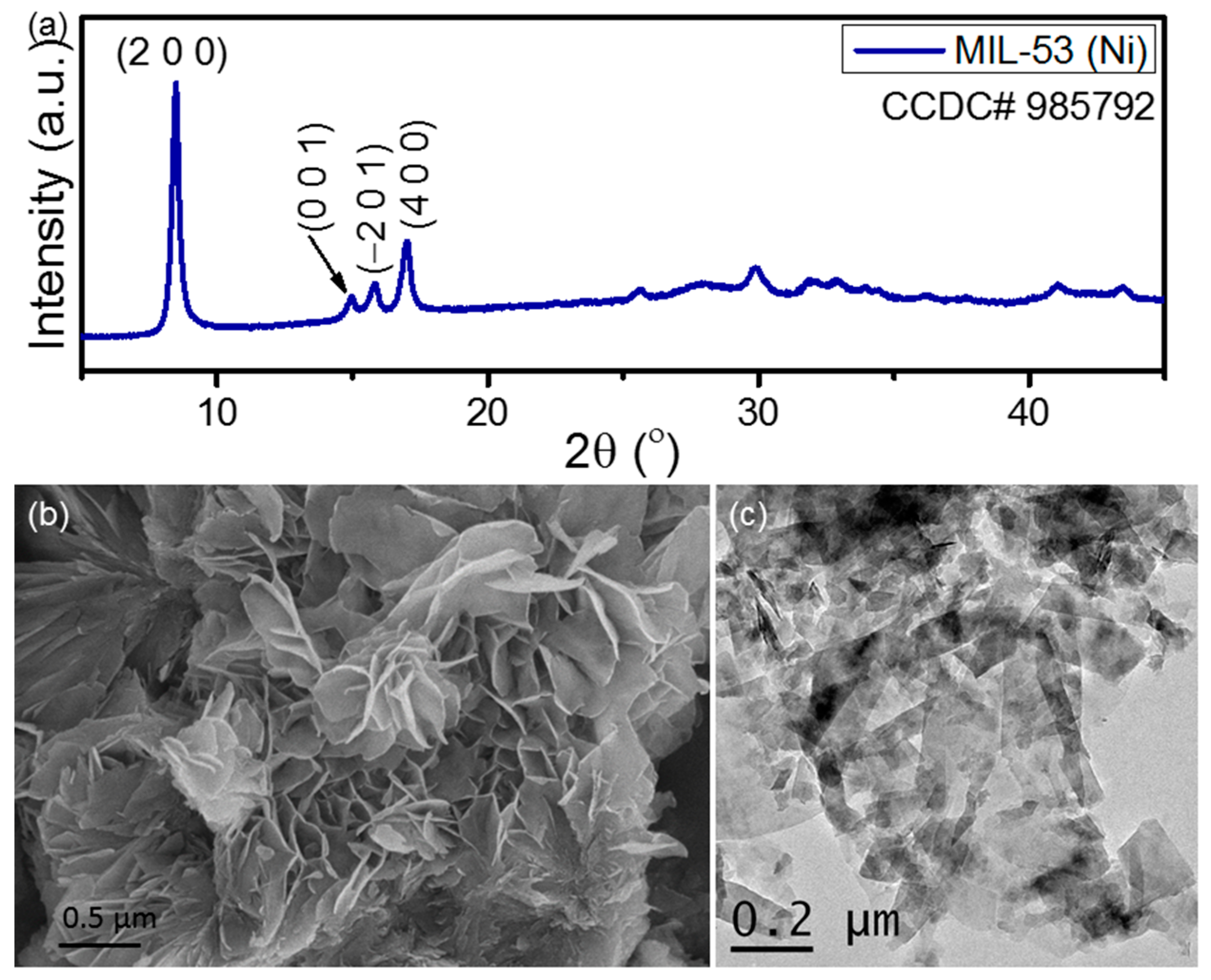

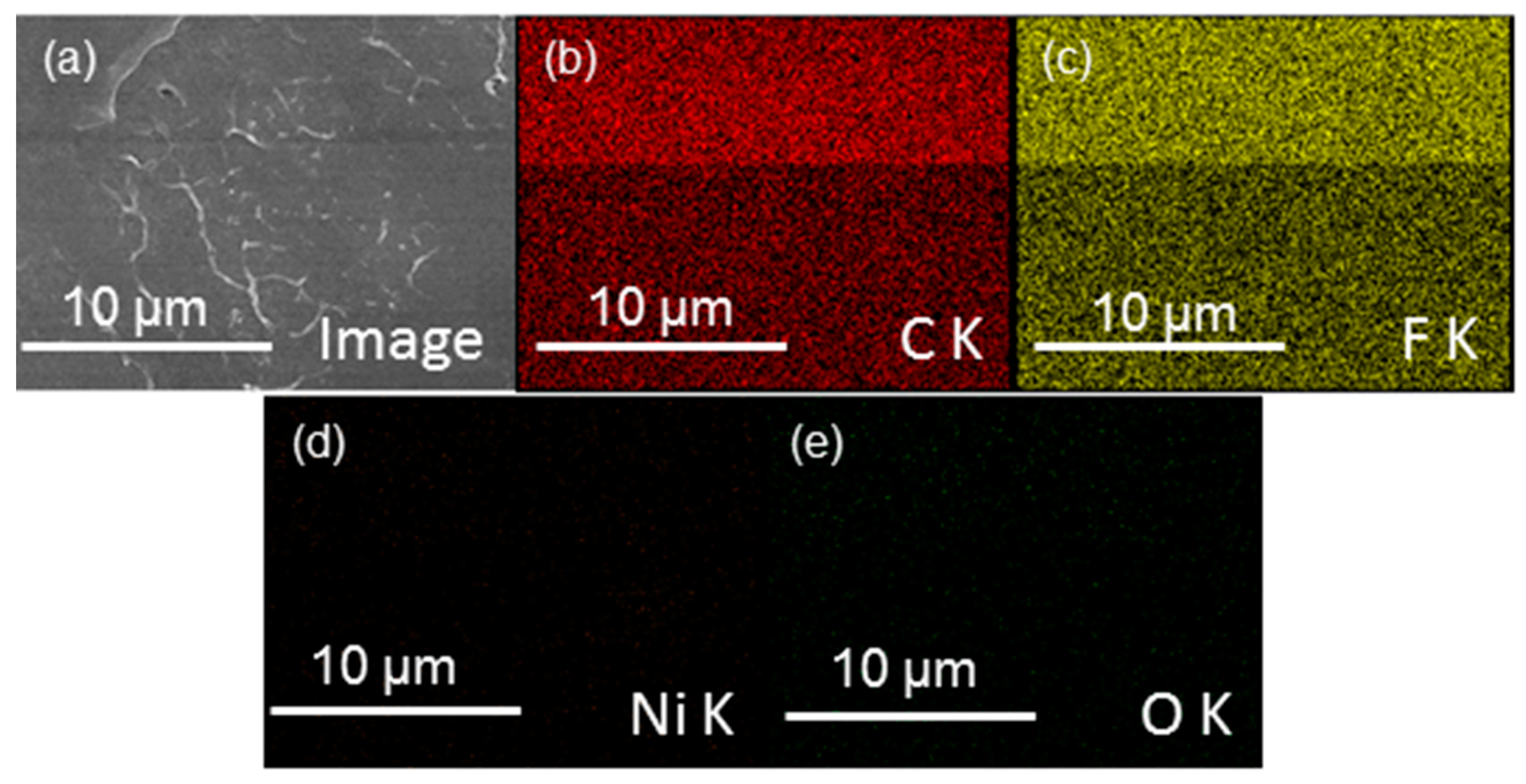

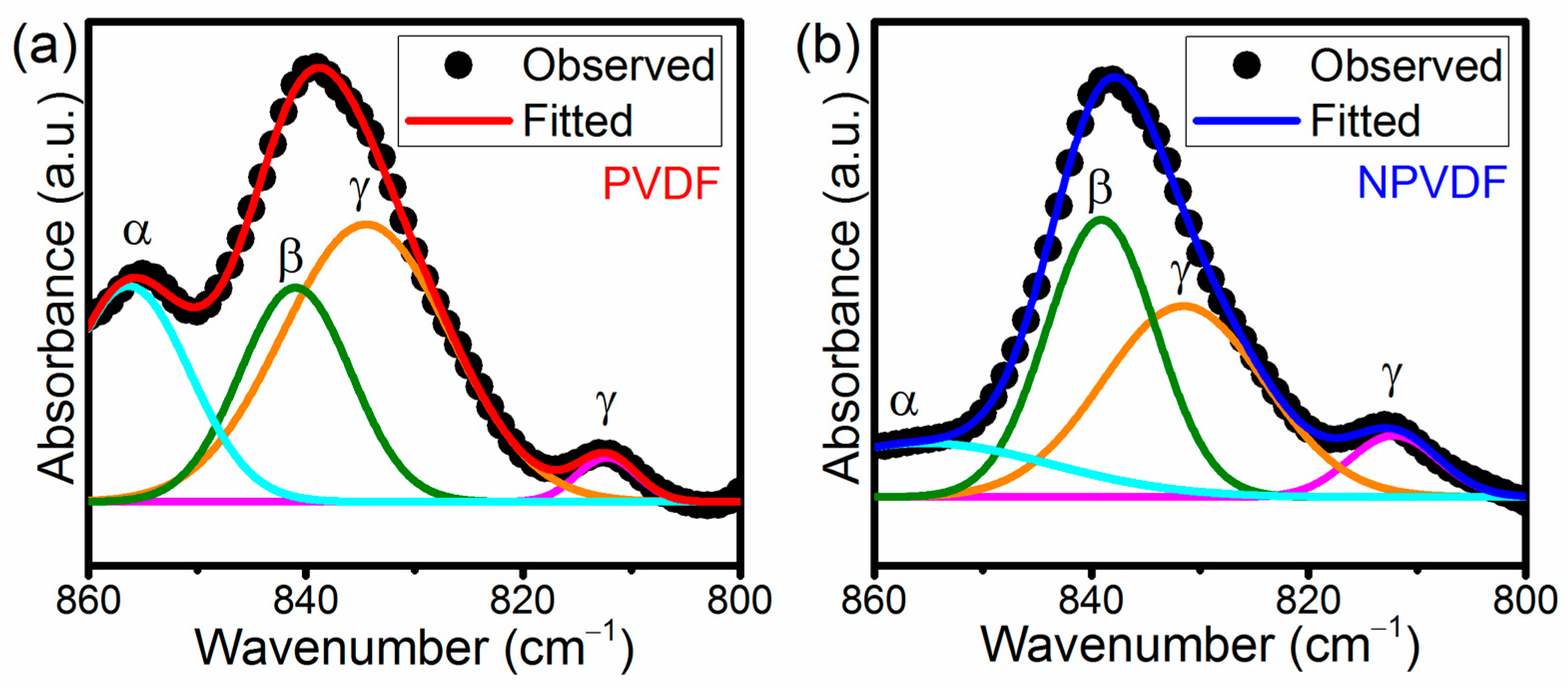
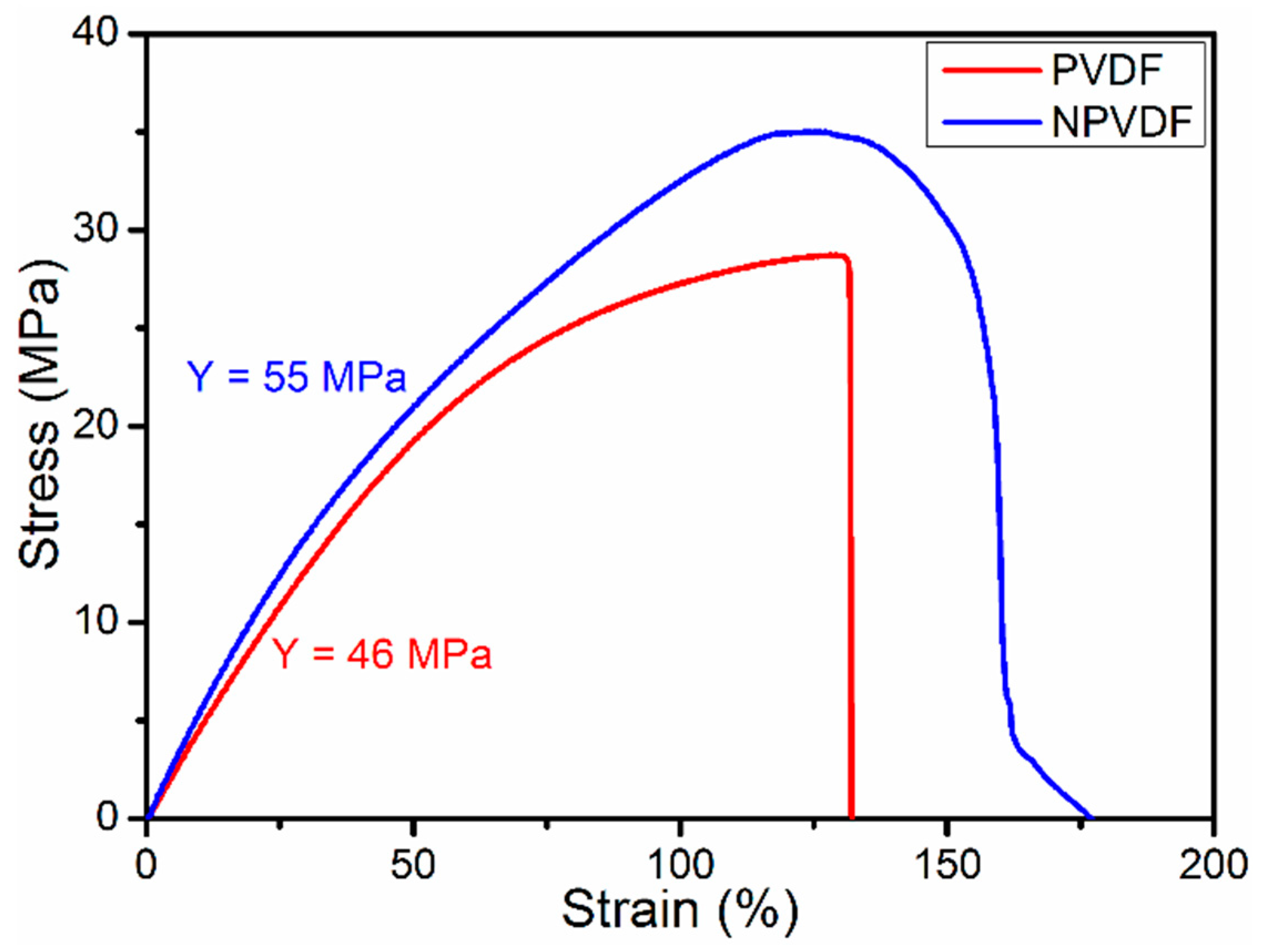
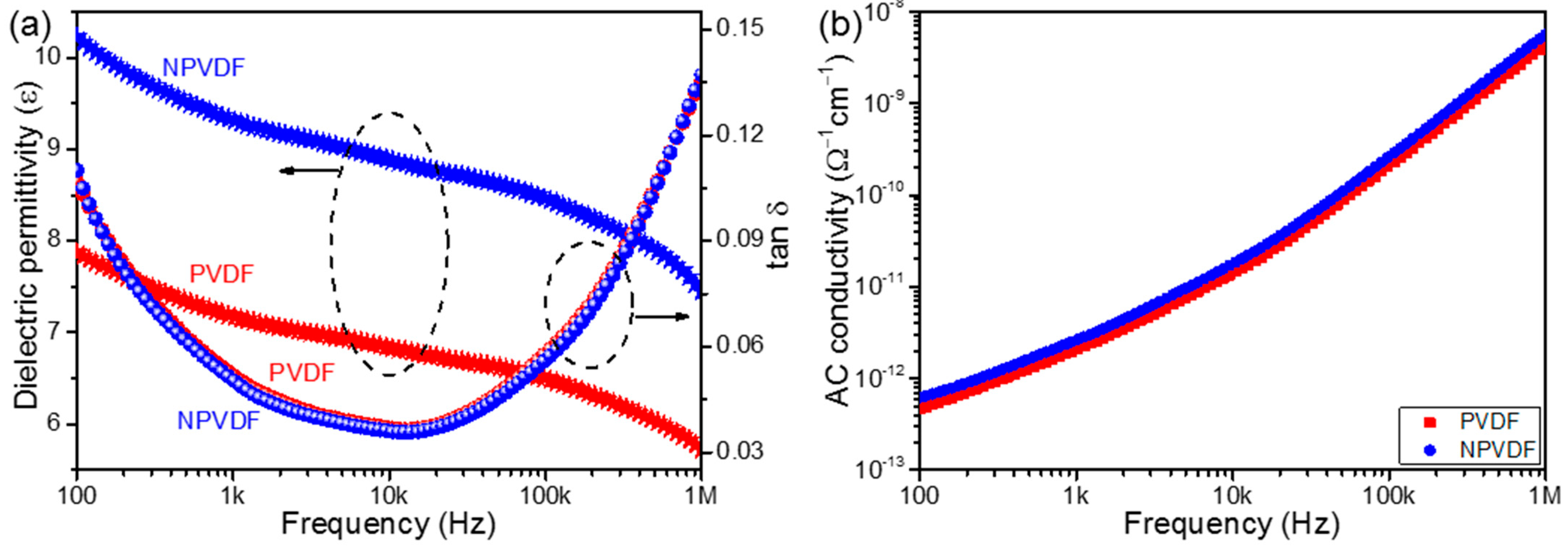
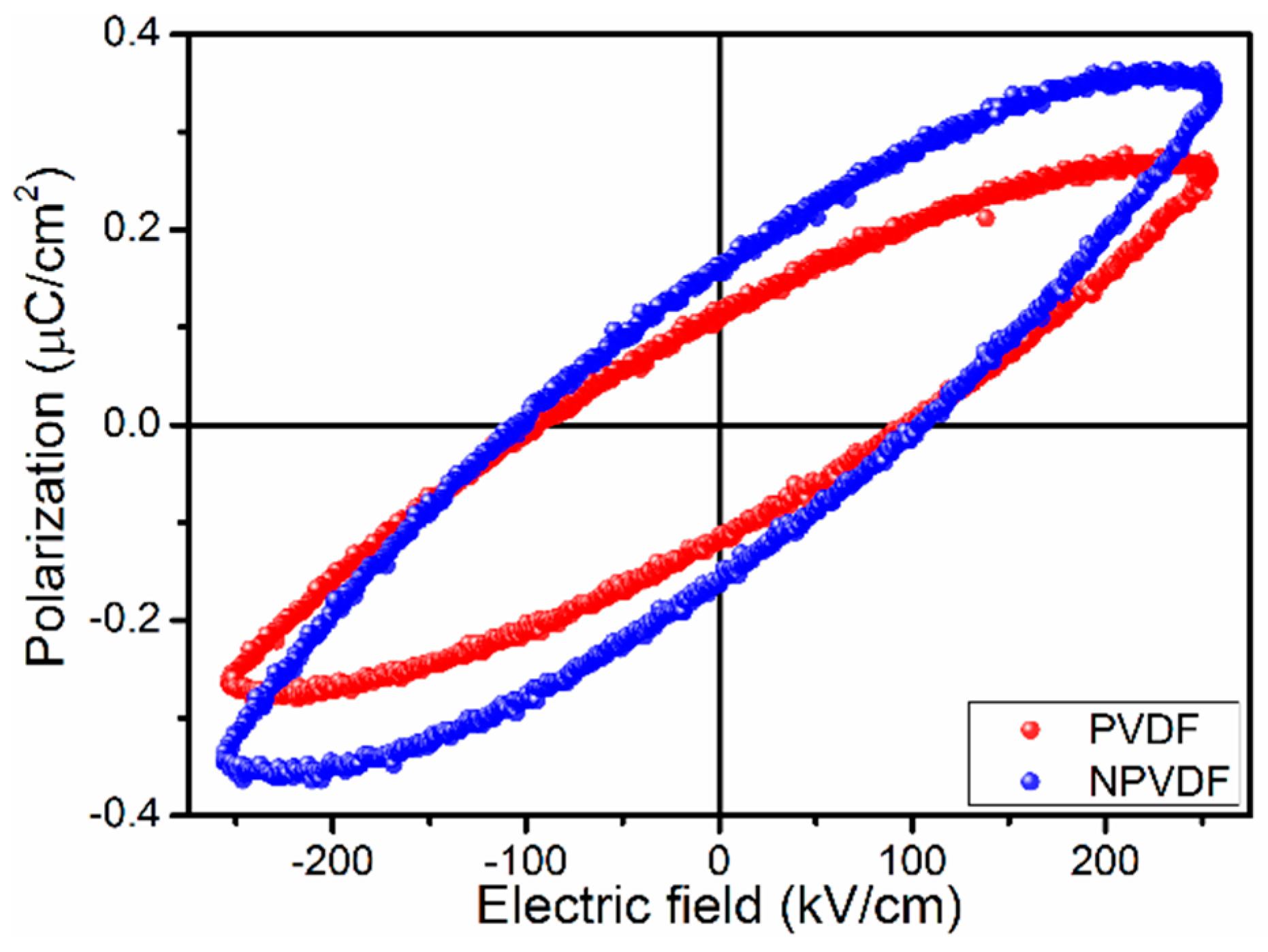
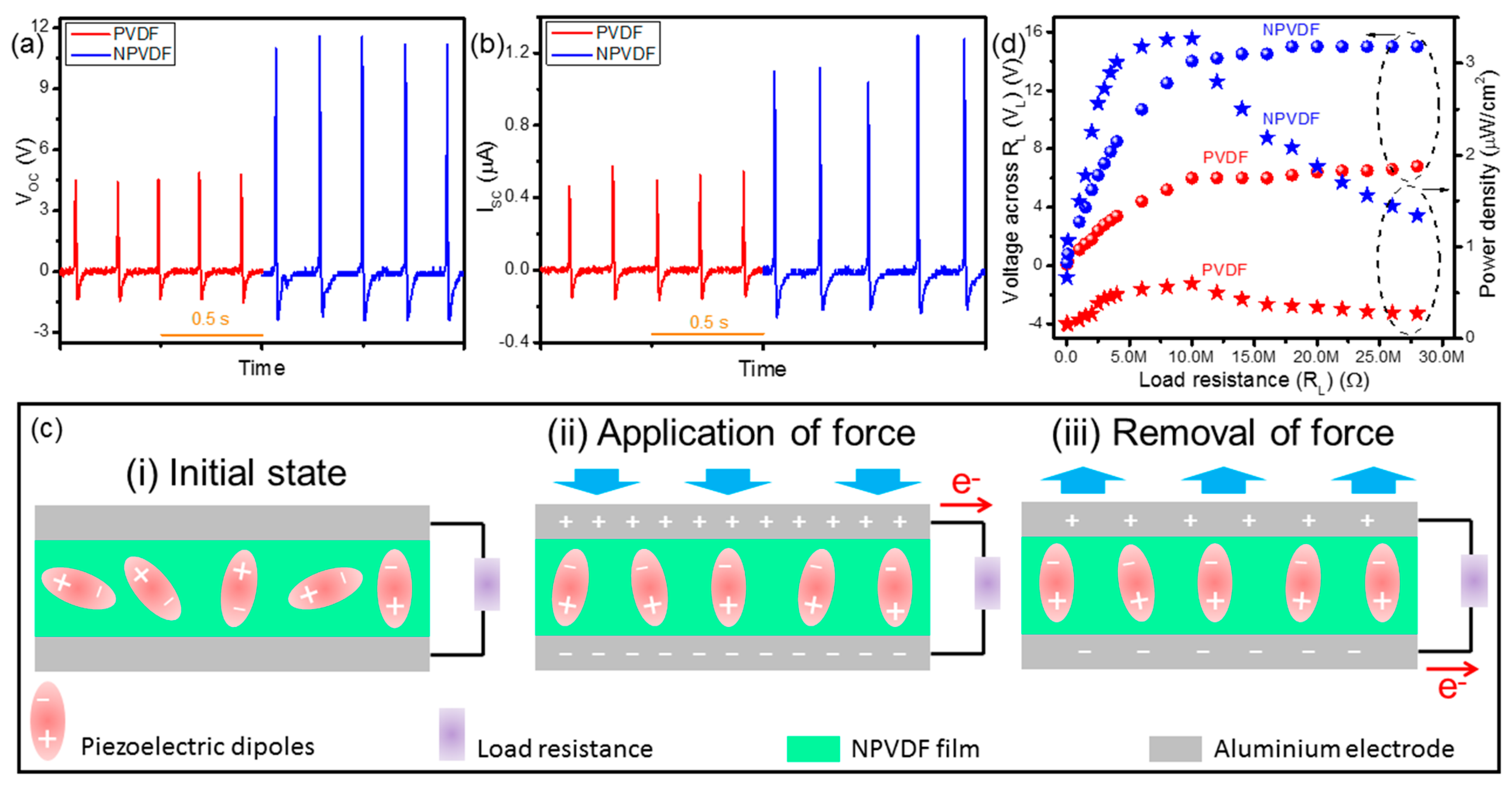
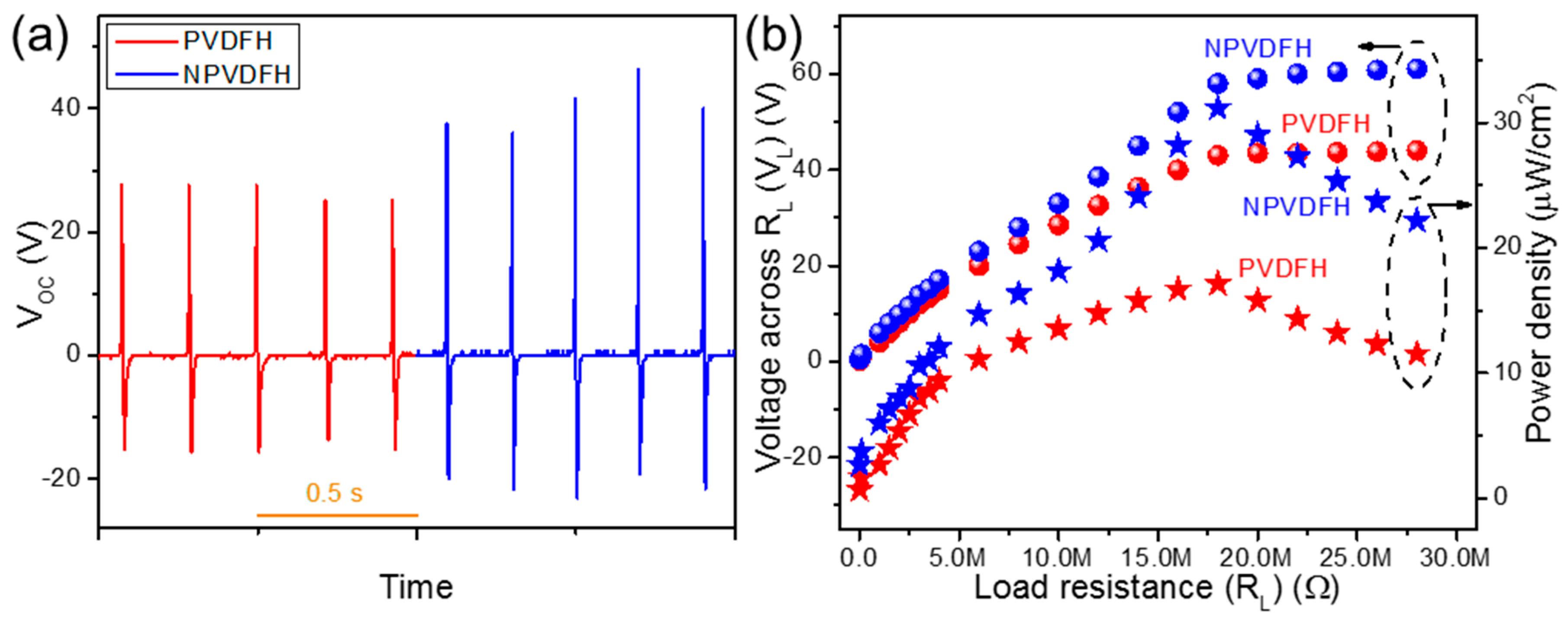
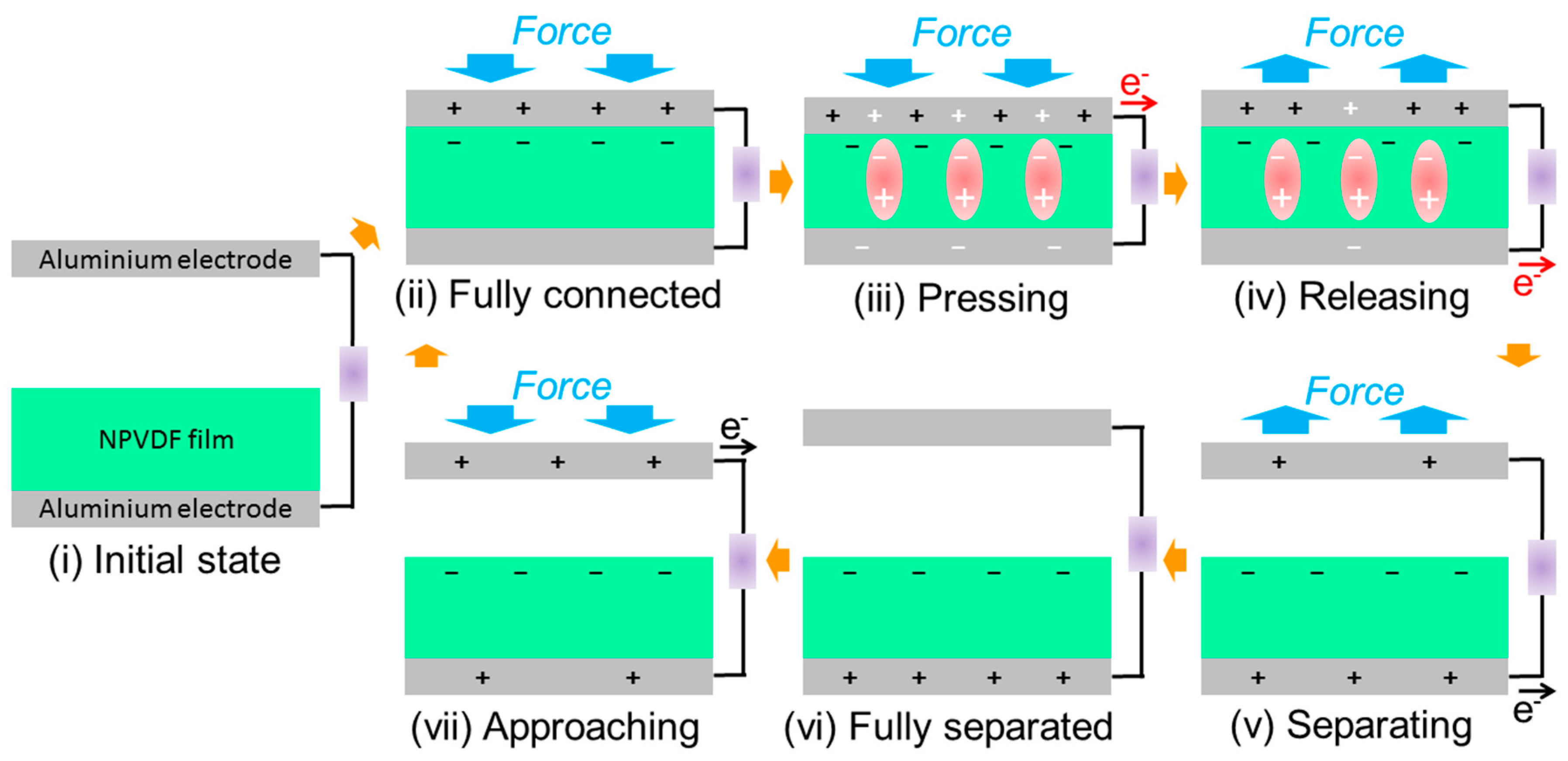

| Sample | PVDF | NPVDF | ||||||
|---|---|---|---|---|---|---|---|---|
| Elements | Carbon | Fluorine | Nickel | Oxygen | Carbon | Fluorine | Nickel | Oxygen |
| Weight% | 48.88 | 51.12 | - | - | 53.68 | 45.69 | 0.08 | 0.55 |
| Atomic% | 60.19 | 39.81 | - | - | 64.68 | 34.80 | 0.02 | 0.50 |
| Sl. No. | Polymer Matrix | Filler Material | Filler Concentration | F(EA) (%) | Ref. No. |
|---|---|---|---|---|---|
| 1. | PVDF | Bi0.9Ba0.1FeO3 | 7 wt% | 82 | [11] |
| 2. | PVDF | ZnO nanorod | 20 wt% | 88 | [24] |
| 3. | PVDF | Mo0.5W0.5S2 nanosheet | ~28 wt% | 90 | [28] |
| 4. | PVDF | WS2 nanosheet | ~0.25 wt% | 85 | [30] |
| 5. | PVDF | Graphite platelet | 0.5 wt% | 95 | [33] |
| 6. | PVDF | [CdI2-INH=CMe2 (3D MOF) | 1 wt% | 98 | [38] |
| 7. | PVDF | CsPbBr3 nanorod | 5 wt% | 90 | [49] |
| 8. | PVDF | Ba0.6Sr0.4TiO3 | 20 wt% | 90 | [50] |
| 9. | PVDF | PEG-modified ZnFe2O4 | 10 wt% | 92 | [51] |
| 10. | PVDF | 2D Ni-MOF | 0.5 wt% | 85 | This work |
| Sample Name | F(EA) (%) | F(β) (%) | F(γ) (%) | F(βγ) (%) | F(γβ) (%) |
|---|---|---|---|---|---|
| PVDF | 55.1 | 26.29 | 28.80 | 47.72 | 52.28 |
| NPVDF | 84.6 | 42.20 | 42.40 | 49.88 | 50.12 |
| Sl. No. | Device Structure (Lower Layer/Upper Layer) | P (μW/cm2) | RL at P (MΩ) | VL (V) | IL (μA) | Ref. No. |
|---|---|---|---|---|---|---|
| 1. | PVDF-TrFE+PEDOT:PSS/PI | 1.28 | 10 | 15.6 | ~1 | [67] |
| 2. | PVDF+ZnO/PTFE | 24.5 | 140 | ~78 | - | [68] |
| 3. | PVDF+BaTiO3/Nylon | 22.5 | 100 | 160 | ~1 | [69] |
| 4. | PVDF+NaNbO3 (Polarised)/PTFE | 22.6 | 100 | 160 | - | [70] |
| 5. | PVDF+Dopamine@SnO2/Paper | 81 | ~100 | ~100 | - | [71] |
| 6. | PVDF+BCZT/Al | 76.7 | 20 | 89.8 | 4.8 | [59] |
| 7. | PVDF+BiFeO3/Al | 61 | 20 | 80 | ~4 | [63] |
| 8. | PVDF+Ni-MOF/Al | 31 | 18 | 61 | 3.26 | This work |
Disclaimer/Publisher’s Note: The statements, opinions and data contained in all publications are solely those of the individual author(s) and contributor(s) and not of MDPI and/or the editor(s). MDPI and/or the editor(s) disclaim responsibility for any injury to people or property resulting from any ideas, methods, instructions or products referred to in the content. |
© 2023 by the authors. Licensee MDPI, Basel, Switzerland. This article is an open access article distributed under the terms and conditions of the Creative Commons Attribution (CC BY) license (https://creativecommons.org/licenses/by/4.0/).
Share and Cite
Sasmal, A.; Senthilnathan, J.; Arockiarajan, A.; Yoshimura, M. Two-Dimensional Metal-Organic Framework Incorporated Highly Polar PVDF for Dielectric Energy Storage and Mechanical Energy Harvesting. Nanomaterials 2023, 13, 1098. https://doi.org/10.3390/nano13061098
Sasmal A, Senthilnathan J, Arockiarajan A, Yoshimura M. Two-Dimensional Metal-Organic Framework Incorporated Highly Polar PVDF for Dielectric Energy Storage and Mechanical Energy Harvesting. Nanomaterials. 2023; 13(6):1098. https://doi.org/10.3390/nano13061098
Chicago/Turabian StyleSasmal, Abhishek, Jaganathan Senthilnathan, Arunachalakasi Arockiarajan, and Masahiro Yoshimura. 2023. "Two-Dimensional Metal-Organic Framework Incorporated Highly Polar PVDF for Dielectric Energy Storage and Mechanical Energy Harvesting" Nanomaterials 13, no. 6: 1098. https://doi.org/10.3390/nano13061098
APA StyleSasmal, A., Senthilnathan, J., Arockiarajan, A., & Yoshimura, M. (2023). Two-Dimensional Metal-Organic Framework Incorporated Highly Polar PVDF for Dielectric Energy Storage and Mechanical Energy Harvesting. Nanomaterials, 13(6), 1098. https://doi.org/10.3390/nano13061098







